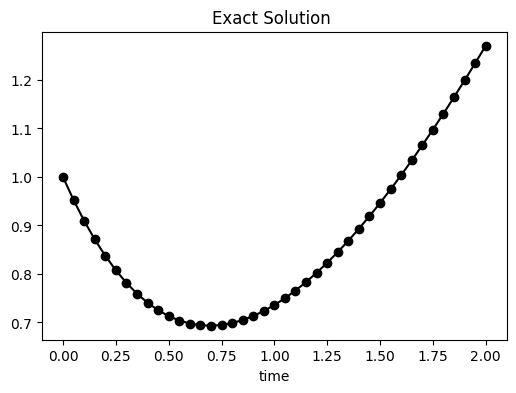Consistency of a Multistep method#
John S Butler#
john.s.butler@tudublin.ie
Course Notes Github
Overview#
A one-step or multistep method is used to approximate the solution of an initial value problem of the form
with the initial condition
The method should only be used if it satisfies the three criteria:
that difference equation is consistent with the differential equation;
that the numerical solution is convergent to the exact answer of the differential equation;
that the numerical solution is stable.
In the notebooks in this folder we will illustate examples of consisten and inconsistent, convergent and non-convergent, and stable and unstable methods.
Introduction to Consistency#
In this notebook we will illustate an inconsistent method.
from IPython.display import HTML
HTML('<iframe width="560" height="315" src="https://www.youtube.com/embed/SXH6WHMLTII" frameborder="0" allow="accelerometer; autoplay; clipboard-write; encrypted-media; gyroscope; picture-in-picture" allowfullscreen></iframe>')
/Users/johnbutler/opt/anaconda3/lib/python3.8/site-packages/IPython/core/display.py:724: UserWarning: Consider using IPython.display.IFrame instead
warnings.warn("Consider using IPython.display.IFrame instead")
Definition#
A one-step and multi-step methods with local truncation error \(\tau_{i}(h)\) at the \(i\)th step is said to be consistent with the differential equation it approximates if
where
As \(h \rightarrow 0\) does \(F(t_i,y_i,h,f) \rightarrow f(t,y)\).
All the Runge Kutta, and Adams methods are consistent in this course. This notebook will illustrate a non-consistent method which with great hubris I will call the Abysmal-Butler methods.
2-step Abysmal Butler Method#
The 2-step Abysmal Butler difference equation is given by
which can be written as
Intial Value Problem#
To illustrate consistency we will apply the method to a linear intial value problem given by
with the initial condition
with the exact solution
Python Libraries#
import numpy as np
import math
import pandas as pd
%matplotlib inline
import matplotlib.pyplot as plt # side-stepping mpl backend
import matplotlib.gridspec as gridspec # subplots
import warnings
warnings.filterwarnings("ignore")
Defining the function#
$$ f(t,y)=t-y.\end{equation}
def myfun_ty(t,y):
return t-y
Discrete Interval#
Defining the step size \(h\) from the interval range \(a \leq t\leq b\) and number of steps \(N\)
This gives the discrete time steps,
where \(t_0=a.\)
Here the interval is \(0\leq t \leq 2\) and number of step 40
This gives the discrete time steps,
for \(i=0,1,⋯,40.\)
# Start and end of interval
b=2
a=0
# Step size
N=40
h=(b-a)/(N)
t=np.arange(a,b+h,h)
fig = plt.figure(figsize=(10,4))
plt.plot(t,0*t,'o:',color='red')
plt.xlim((0,2))
plt.title('Illustration of discrete time points for h=%s'%(h))
plt.show()

Exact Solution#
The initial value problem has the exact solution $$y(t)=2e^{-t}+t-1.\end{equation} The figure below plots the exact solution.
IC=1 # Intial condtion
y=(IC+1)*np.exp(-t)+t-1
fig = plt.figure(figsize=(6,4))
plt.plot(t,y,'o-',color='black')
plt.title('Exact Solution ')
plt.xlabel('time')
plt.show()

# Initial Condition
w=np.zeros(N+1)
#np.zeros(N+1)
w[0]=IC
2-step Abysmal Butler Method#
The 2-step Abysmal Butler difference equation is
For \(i=0\) the system of difference equation is:
this is not solvable as \(w_{-1}\) is unknown.
For \(i=1\) the difference equation is:
this is not solvable as \(w_{1}\) is unknown. \(w_1\) can be approximated using a one step method. Here, as the exact solution is known,
### Initial conditions
w=np.zeros(len(t))
w0=np.zeros(len(t))
w[0]=IC
w[1]=y[1]
Loop#
for k in range (1,N):
w[k+1]=(w[k]+h/2.0*(4*myfun_ty(t[k],w[k])-3*myfun_ty(t[k-1],w[k-1])))
Plotting solution#
def plotting(t,w,y):
fig = plt.figure(figsize=(10,4))
plt.plot(t,y, 'o-',color='black',label='Exact')
plt.plot(t,w,'^:',color='red',label='Abysmal-Butler')
plt.xlabel('time')
plt.legend()
plt.show
The plot below shows the exact solution (black) and the Abysmal-Butler approximation (red) of the intial value problem.
The Numerical approximation does not do a good job of approximating the exact solution and that is because it is inconsistent.
plotting(t,w,y)

Consistency#
To prove that the Abysmal-Butler method does not satisfy the consistency condition,
As \(h \rightarrow 0\)
While as \(h \rightarrow 0\)
Hence as \(h \rightarrow 0\) \begin{equation} \frac{y_{i+1}-y_{i}}{h}-\frac{1}{2}[4(f(t_i,y_i)-3f(t_{i-1},y_{i-1})]\rightarrow f(t_i,y_i)-\frac{f(t_i,y_i)}{2}=\frac{f(t_i,y_i)}{2},\end{equation} which violates the consistency condition (inconsistent).
d = {'time': t[0:5], 'Abysmal Butler': w[0:5],'Exact':y[0:5],'Error':np.abs(y[0:5]-w[0:5])}
df = pd.DataFrame(data=d)
df
| time | Abysmal Butler | Exact | Error | |
|---|---|---|---|---|
| 0 | 0.00 | 1.000000 | 1.000000 | 0.000000 |
| 1 | 0.05 | 0.952459 | 0.952459 | 0.000000 |
| 2 | 0.10 | 0.937213 | 0.909675 | 0.027538 |
| 3 | 0.15 | 0.921176 | 0.871416 | 0.049760 |
| 4 | 0.20 | 0.906849 | 0.837462 | 0.069388 |
